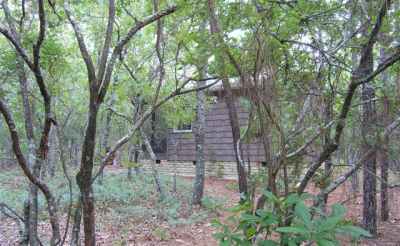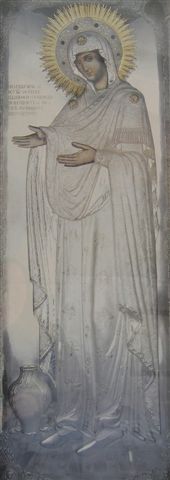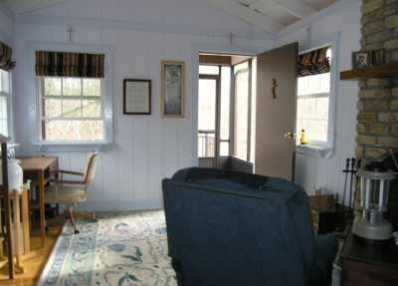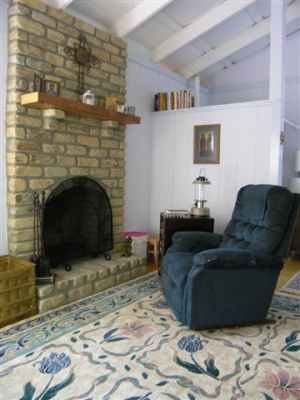

Draw aside from life's busyness and
"Be still and know that I am God"
(Psalm 45/46: 10)
Under the protection of the Theotokos
(Birthgiver of God the Son, Jesus),
this Hermitage provides a "place apart"
for an individual.
While the Hermitage is comfortable,
it is rustic in that
there is no electricity or running water.
However, there is a fireplace
for heat in the winter.
There are three choices in how you arrange for your stay:
1) You can be totally alone by bringing
your own food.
2) We will provide you with picnic basket
meals.
3) You can choose a combination of the above and join the monastics for supper.
Reservations must be made in advance.
Donations are gratefully accepted.


Three views of the Interior of
Theotokos the Eldress Hermitage





Story Behind the Icon of Theotokos the Eldress
The icon that hangs in the Hermitage was given to us by a friend of the monastery, who, after praying to the Theotokos as to where she wanted her icon to hang, was told that it should be placed in the little building in the woods at our monastery.
This miraculous icon was a gift from the Byzantine Emperor Alexius I Comnenus (1081-1118) to the Monastery Koinviaki. It is a copy of the mosaic icon of "She Who is Quick to Hear", which is kept in the Monastery of Pandokratoros in Constantinople. The name of the icon was changed from "She Who is Quick to Hear" to "The Eldress" due to a miracle that occurred at the Monastery Koinviaki. The Abbot was very old and knew that he would soon die. He longed to receive the Holy Eucharist one last time. The monk serving the Liturgy was very slow and the Abbot asked him to hurry the service along because he knew he would soon die. The monk ignored his request and continued serving at an even slower pace. Suddenly, the icon of the Mother of God spoke, interceding on behalf of the Abbot. The surprised monk was obedient and quickened the pace of the service. The Abbot reposed immediately upon receiving Holy Communion. The icon was renamed "The Eldress" due to her close relationship with the Abbot. After this, the icon was moved from behind the altar to a column on the left side of the church so people could venerate her.
The oil pot at her feet is in memory of the following miracle which happened at the monastery during the 17th century. There was nothing of value left in the monastery, not even a cruet of oil. The monks had decided to close the monastery and leave when the Abbot pleaded with them to have faith and pray to The Eldress. After agreeing with the Abbot, they prayed for her help. The Holy Mother heard their prayers. In the morning, the monks saw oil coming from under the door where the empty oil pots were stored. When they opened the cellar door, they saw an oil pot overflowing with oil. Understanding that this was in answer to their prayers, they filled all of the other oil pots. Only then did the pot that was overflowing with oil cease. That oil pot was then set beside her icon. From that time, the monastery has never been short of oil.
After this, The Eldress instructed a wealthy woman of Constantinople that she desired to be dressed in a rich garment and to commission a silver and gold covering (riza) for her.
Another miracle happened during one of the raids of the Sarakion pirates. They looted the monastery of many valuable items including the icon of The Eldress. One of the pirates decided to remove the silver and gold covering (riza) and to break a piece of wood from the icon to light his smoke in a show of dishonor. Upon striking the icon, smoke and fire came from the icon striking fear into his heart and blinding him. In panic, the other pirates threw the icon into the well in the monastery garden and fled. Since the monks had fled the monastery, they were unaware of this incident. Eighty years later, the pirate, who remembered the episode with the icon, knew that his death was near, and, needing to find peace of soul, relayed the incident to his relatives and begged them to go and tell the monks. Agreeing to this, the pirate's relatives journeyed to the monastery, recounted the event to the monks, and showed them where the well had been. When they opened the well, they found the icon standing up in the middle of the well with water up to her knees and not touching any side of the well. The icon was returned to the place in the church where it had been eighty years earlier, and a lamp (kandilli or lampada) was lit in front of the icon.Many miracles have occurred down to our own day through the intercession of The Eldress. Women who could not conceive have become pregnant. People with cancer and other chronic illnesses have received healing. Those seeking guidance have been given answers and direction. Even the holy water from the well where The Eldress stood for eighty years has bestowed blessings upon the faithful.
The monks decided to commemorate this icon on December 2nd after a miracle occurred in December 1948. A fire broke out in the monastery which threatened to completely destroy it. The desperate monks made a small paper copy of The Eldress icon, prayed, and blessed it with the Sign of the Cross. They held the paper icon over the flames, made the Sign of the Cross with it, and the fire went out. The face of the Theotokos the Eldress is full of peace, mercy and love, thus filling the faithful with joy, hope, peace and love. The pleasant sweetness of her countenance reassures us that she is compassionate toward all mankind, is concerned for their needs, and is in constant prayer for the whole world before her Son and God, Jesus Christ.